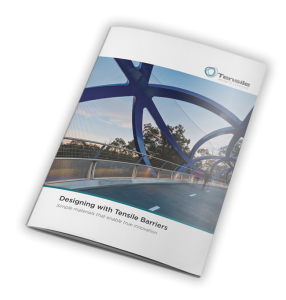Tensile is committed to improved sustainability in architecture, and our tensile solutions reflect this.
According to the World Green Building Council, buildings are responsible for almost 40% of energy-related CO2 emissions globally. Making buildings more sustainable can help mitigate this.
This can be achieved through improved energy efficiency (e.g. embedded passive heating and cooling), use of resilient recycled materials, simplified and faster construction, reduced waste, materials, and labour, and designing for longevity and local climate.
Aiming for better sustainability is not only good for the environment – it also helps reduce costs associated with materials, labour, and ongoing maintenance.
Sustainability benefits of tensile solutions
Tensile structures by their very nature tend to be lighter on the environment than solid construction.
Fabric and stainless-steel tensile structures can usually be built faster, require less materials, have lower maintenance needs and utilise efficient building methods such as prefabrication.
At Tensile, we use Jakob stainless steel materials in the form of wire rope cables and pre-formed Webnet mesh for our projects.
These materials can be used to create near-transparent building facades and safety barriers, and come with a range of benefits:
- Made from an average 70% recycled content.
- Manufactured in facilities that run on 90-100% renewable energy.
- Robustness and durability – lasting 25 years or even more, helping to minimise waste.
- Very low ongoing maintenance needs.
- Resistance to disasters such as bushfires and floods.
- Recyclable when dismantled.
Many of the installations can be pre-fabricated off-site – saving time and reducing the risk of costly disruptions.
Projects with sustainability at the centre

We have designed tensile solutions for several projects where sustainability has been a key focus.
Nightingale Village
Melbourne’s Nightingale Village consists of a set of low-carbon sustainable residential buildings. Our role was to install Webnet safety barriers and wire-rope cable green facades for the ‘ParkLife’ building.
Being lightweight yet highly robust makes these materials suitable for heavy usage and the harsh outdoors, and ideal for buildings such as this one where sustainability is a key feature.
ParkLife won a design award for environmental sustainability.
Student precinct
Melbourne University’s new student precinct is focused on sustainability, inclusion and connectedness. The precinct required robust, transparent safety barriers for the student pavilion balconies.
For the barrier installation we used 30mm Webnet. The barriers allow for student interaction, have low ongoing maintenance needs and were quick and easy to install, aligning with the precinct’s sustainability and community focus.
Bridges
At the Bundanon Museum & Bridge, our brief was to build a safety barrier for the bridge that would offer transparency while being robust, disaster-resistant and low-maintenance.
To meet this brief, we used Jakob 80mm-aperture Webnet mesh. Webnet’s durability means the barrier should last for decades with minimal interference.
The Bundanon project was the winner of a national award for sustainable architecture.
Another example is the Christopher Cassaniti Bridge at Ryde in Sydney, which was built using recyclable stainless steel and sustainable building practices such as off-site pre-construction. The transparent anti-throw Webnet screen was constructed in the same way, using 3D modelling to create each unique panel off-site ahead of the installation.
SkyPark Garden
Tensile built the Webnet perimeter safety barrier for the elevated SkyPark Garden in Melbourne. This barrier doubles-up as a climbing plant trellis for greening and balances the need for both transparency and safety.
SkyPark forms part of ‘Melbourne Quarter’ development, which was awarded the highest sustainability rating for Green Communities.
Carparks
Webnet can even be used to make sustainable safety barriers for multi-storey carparks. Barriers like the one at the Thomas Street Dandenong carpark are very quick to install (this one only took three weeks!) and can avoid the need for expensive restructuring and costly air-exchange systems.
Future trends in sustainability
The drive towards sustainability will continue to impact architectural design, processes and materials going forward. Trends like passive design, use of recycled and recyclable materials, biophilic design and carbon net-zero construction will continue to evolve. We’re looking forward to seeing what the future holds, particularly when it comes to more sustainable materials and processes, we can offer our customers!
Do you have a project in the pipeline requiring a more sustainable barrier or facade? Get in touch to find how we can help.






































